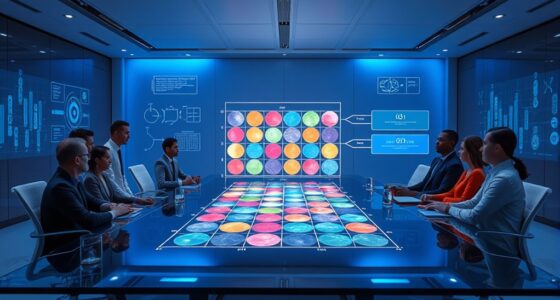As a designer, you work alongside intelligent systems by leveraging AI to handle repetitive tasks, analyze datasets, and generate initial concepts. This frees you to focus on nuanced, creative decisions that require intuition and emotional insight. AI suggests color schemes, layouts, and patterns, expanding your options. Ethical considerations, transparency, and critical evaluation are key to responsible collaboration. Continuing to explore this partnership reveals how to harness AI’s full potential ethically and effectively.
Key Takeaways
- AI automates repetitive tasks and initial concept generation, allowing designers to focus on nuanced, creative aspects.
- Designers utilize AI suggestions for color schemes, layouts, and patterns to enhance innovation and efficiency.
- Collaboration requires transparency and ethical oversight to ensure AI influences align with fairness and user privacy.
- Human judgment guides final design choices, maintaining authenticity and originality amid AI-generated ideas.
- Responsible use involves critical evaluation of AI outputs, addressing biases, and balancing technological benefits with ethical standards.

As artificial intelligence continues to advance, human-AI collaboration is transforming the way we work, solve problems, and innovate. When you work alongside intelligent systems, you tap into a form of creative synergy that amplifies your abilities and sparks new ideas. AI tools can handle repetitive tasks, analyze vast datasets, and generate initial concepts, freeing you to focus on the more nuanced aspects of design that require human intuition and emotional insight. This partnership allows you to experiment more freely, iterate faster, and push creative boundaries you might not have explored alone. However, as you integrate AI into your workflow, you must also consider ethical considerations. It’s essential to think about how these systems influence decision-making, uphold fairness, and respect user privacy. Predictive analytics can offer valuable insights into customer behavior, supporting more informed design choices. Ensuring transparency in AI decision-making processes is crucial to build trust and accountability. It’s also important to ensure compliance with data protection regulations and to foster collaboration between stakeholders for ethical standards. Fostering public trust in AI technologies through accountability is essential for sustainable development. In this collaborative environment, you aren’t replacing your creative instincts; instead, you’re augmenting them. AI can suggest color schemes, layout options, or patterns based on current trends or user preferences, but your input guides the final vision. The technology acts as a partner that offers fresh perspectives, helping you see possibilities you might overlook. Yet, this also raises questions about originality and authorship. As you incorporate AI-generated ideas, you must decide what to keep, adapt, or discard, maintaining your unique voice while leveraging the system’s strengths. It’s a delicate balance—fostering innovation without sacrificing authenticity or ethical integrity. Moreover, embracing human-AI collaboration means staying vigilant about potential pitfalls. You need to understand the limitations of these systems, recognizing that AI isn’t infallible. Biases embedded in training data can lead to unintended outcomes, so you must critically evaluate AI suggestions and ensure they align with your ethical standards. The collaboration isn’t just about productivity; it’s about creating responsibly and thoughtfully. By doing so, you help set a standard for ethical AI use in design, emphasizing transparency and accountability. Ultimately, your role in human-AI collaboration is to orchestrate a harmony where technology complements your creative spirit. You harness AI’s power to streamline processes and inspire innovation, all while maintaining ethical integrity. This partnership isn’t about replacing human ingenuity but enhancing it, opening up new possibilities for design that are both inventive and responsible. As you continue to explore this synergy, remember that your ethical considerations and creative judgment are what truly shape meaningful, impactful work.
Frequently Asked Questions
How Can Designers Ensure Ethical AI Integration?
To guarantee ethical AI integration, you should prioritize algorithm transparency, making sure the AI’s decisions are understandable and explainable. Take moral responsibility by actively questioning biases and potential harm the system could cause. Regularly audit AI outputs, involve diverse stakeholders, and stay updated on ethical standards. By doing so, you create an environment where AI benefits users ethically and responsibly, aligning technology with human values.
What Skills Are Essential for Future Human-Ai Collaboration?
You need to focus on skill adaptation to stay relevant in human-AI collaboration. Developing a good understanding of AI capabilities and limitations helps you design intuitive interfaces that foster seamless interaction. Critical thinking and empathy remain essential, enabling you to anticipate user needs and guarantee ethical integration. By staying flexible and learning new tools, you’ll create more effective, user-friendly systems that enhance collaboration between humans and intelligent systems.
How Do Designers Address AI Bias in Workflows?
Imagine you’re designing an AI-powered hiring tool. You address AI bias by prioritizing algorithm transparency, making it clear how decisions are made. You incorporate bias mitigation techniques, like diverse training data and regular audits, to diminish unfair outcomes. These steps help you build trust, guarantee fairness, and improve the system’s accuracy, ultimately fostering responsible AI use in workflows.
What Are Common Challenges in Co-Creating With AI?
You face challenges like automation pitfalls that can cause over-reliance or misaligned outputs, making collaboration tricky. User adaptation is another hurdle, as users may resist or struggle to understand AI suggestions. To overcome these issues, you need clear communication, flexible workflows, and ongoing training. Embracing feedback helps refine AI collaboration, ensuring it complements your skills rather than replacing or complicating your creative process.
How Does AI Influence Creative Decision-Making Processes?
AI influences your creative decision-making by enabling automated ideation, which sparks new ideas quickly. It also shapes your choices through algorithmic aesthetics, guiding design elements based on data patterns. You can experiment more freely, trusting AI to suggest innovative concepts or refine visuals. This partnership helps you make informed, efficient decisions, blending human intuition with AI’s analytical power to enhance originality and effectiveness in your projects.
Conclusion
In this partnership, you become the compass guiding the ship through uncharted waters, with AI serving as the sturdy sail propelling you forward. Together, you navigate the vast ocean of possibilities, where human intuition and machine precision intertwine like threads in a tapestry. Embrace this collaboration as a dance—each step and turn symbolizing growth and innovation. Ultimately, your synergy shapes a future where creativity and technology weave seamlessly into the fabric of design.









